10 Best Shade-Loving Flowers for Container Gardening
Transform your shaded outdoor spaces with these stunning flowering plants that thrive in low-light conditions. These varieties will bring color and life to your container garden without requiring full sun exposure. Each plant has been selected for its ability to flourish in containers and adapt to shadier environments, making them perfect choices for patios, porches, or any spot that doesn’t receive direct sunlight throughout the day.
- Impatiens offer vibrant blooms in shades of pink, red, white, and purple that brighten any shady corner. These low-maintenance plants flower continuously from spring until frost, creating a constant display of color in your containers. Impatiens prefer consistent moisture and well-draining soil for optimal growth.
- Begonias feature delicate blooms and attractive foliage that thrive in partial to full shade. Their waxy leaves add texture while their flowers provide pops of color in red, pink, white, or orange. Fibrous and tuberous begonia varieties both perform exceptionally well in pots, requiring minimal care once established.
- Fuchsias dangle their distinctive bell-shaped flowers in striking color combinations, attracting hummingbirds to your shade garden. These elegant plants perform best in cooler temperatures and create a dramatic cascading effect in hanging baskets or tall containers. Regular deadheading encourages continuous blooming throughout the season.
- Coleus offers spectacular foliage in countless color combinations from lime green to deep burgundy. Though grown primarily for their leaves, their interesting textures and patterns make them standout container specimens for shaded areas. Pinch back regularly to encourage bushier growth and prevent flowering.
- Heucheras (Coral Bells) provide year-round interest with their colorful foliage ranging from silver to purple to caramel. Their delicate flower stalks rise above the leaves, adding vertical interest to container arrangements. These perennials require well-draining soil and occasional division to maintain vigor.
- Astilbes produce feathery plumes of flowers in shades of pink, red, lavender, and white. Their fern-like foliage adds texture to container gardens even when not in bloom. Plant astilbes in rich, moist soil for best results, making them ideal companions for other shade-loving perennials.
- Hostas showcase stunning foliage in various sizes, colors, and patterns that thrive in containers. Smaller varieties like ‘Blue Mouse Ears’ or ‘Fire Island’ are perfectly suited for pot culture. Their summer flower spikes attract hummingbirds, adding another dimension of interest to your shade garden.
- Torenia (Wishbone Flower) displays trumpet-shaped blooms with distinctive markings that resemble tiny snapdragons. These heat-tolerant annuals flower continuously in shades of purple, pink, and white, filling your containers with color all season. They perform particularly well in humid conditions that challenge other plants.
- Bleeding Heart features distinctive heart-shaped flowers dangling from arching stems in spring. The delicate blooms in pink or white create a romantic, cottage-garden feel in your container display. While they may go dormant in summer heat, their spring show is worth the temporary absence.
- Hellebores (Lenten Rose) bloom in late winter to early spring when most other plants are dormant. Their nodding, cup-shaped flowers in shades of white, pink, purple, and green provide welcome color during the bleakest months. These long-lived perennials maintain attractive evergreen foliage year-round in containers.
Understanding Shade Conditions: Full, Partial, and Dappled Shade
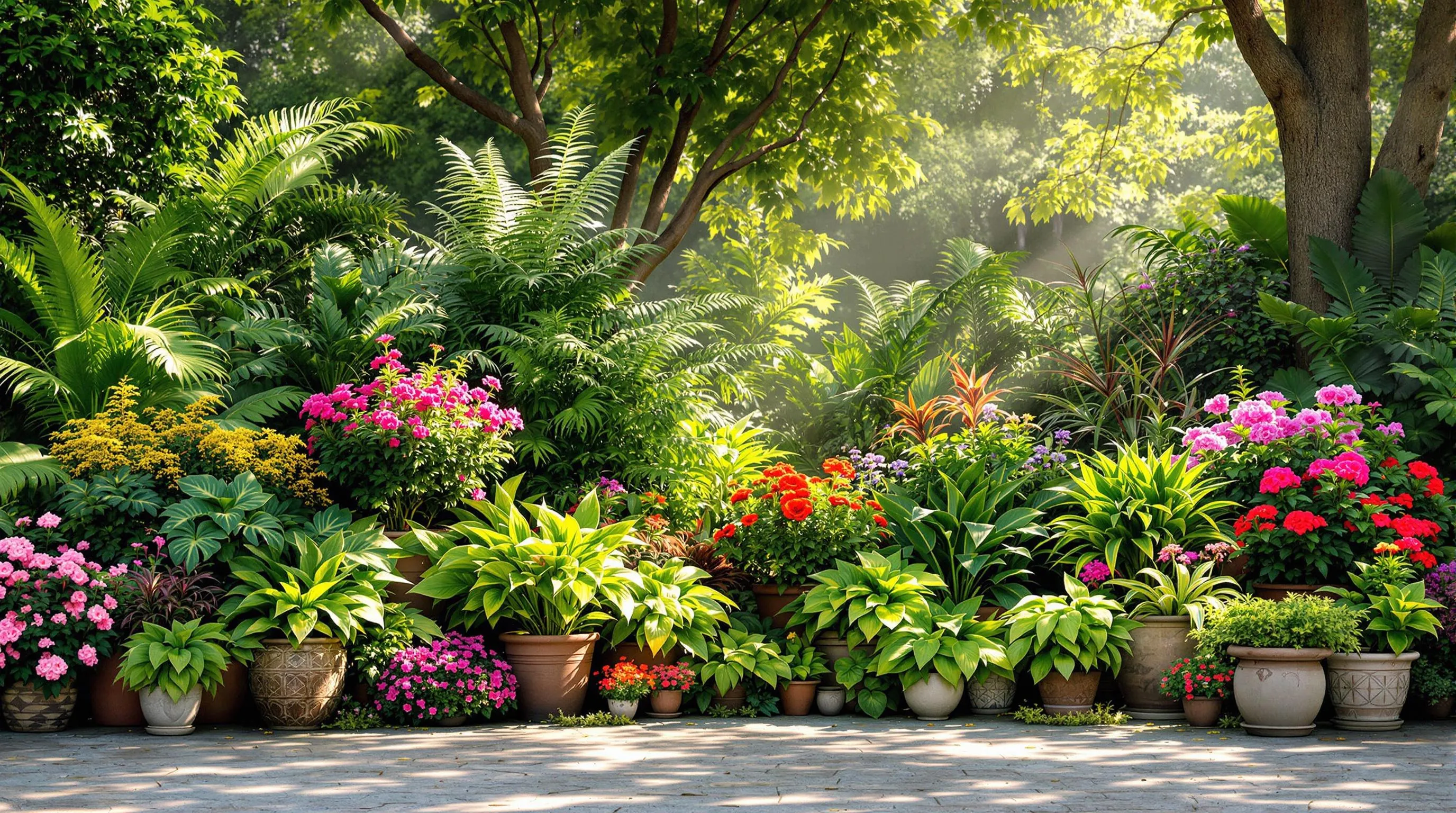
Before selecting flowers for your shaded containers, it’s crucial to understand the different types of shade your space receives. Shade isn’t a one-size-fits-all concept, and identifying your exact shade environment will help you choose plants that’ll truly thrive.
How to Assess Your Shade Environment
To determine your shade conditions, observe your planting area throughout the day. Full shade receives less than 3 hours of direct sunlight daily, often found under dense tree canopies or on the north side of buildings. Partial shade areas get 3-6 hours of sun, typically in morning or late afternoon. Dappled shade occurs when sunlight filters through tree branches, creating a speckled light pattern. Track sun exposure for several days using a sun calculator app or by making hourly observations. Consider seasonal changes too—areas that are shaded in summer might receive more light in winter when deciduous trees lose their leaves. The intensity of shade also varies by geographic location, with northern regions experiencing less intense sunlight than southern areas.
Matching Plants to Your Exact Shade Conditions
Different shade-loving plants have exact preferences within the shade spectrum. For full shade areas, choose ferns, hostas, and astilbes that thrive with minimal sunlight. In partial shade, try begonias, impatiens, and coleus which appreciate morning sun but need protection from harsh afternoon rays. Dappled shade is perfect for heucheras, bleeding hearts, and certain varieties of hydrangeas that benefit from filtered light. Pay attention to plant labels and descriptions that specify shade tolerance levels. Remember that container plants often need more moisture than in-ground plantings, especially in shaded areas where evaporation occurs more slowly. Ensure your containers have proper drainage while maintaining consistent moisture for your shade-loving flowers. By matching plants to your exact shade conditions, you’ll create container displays that remain vibrant and healthy throughout the growing season.
Essential Container Gardening Tips for Shady Spots
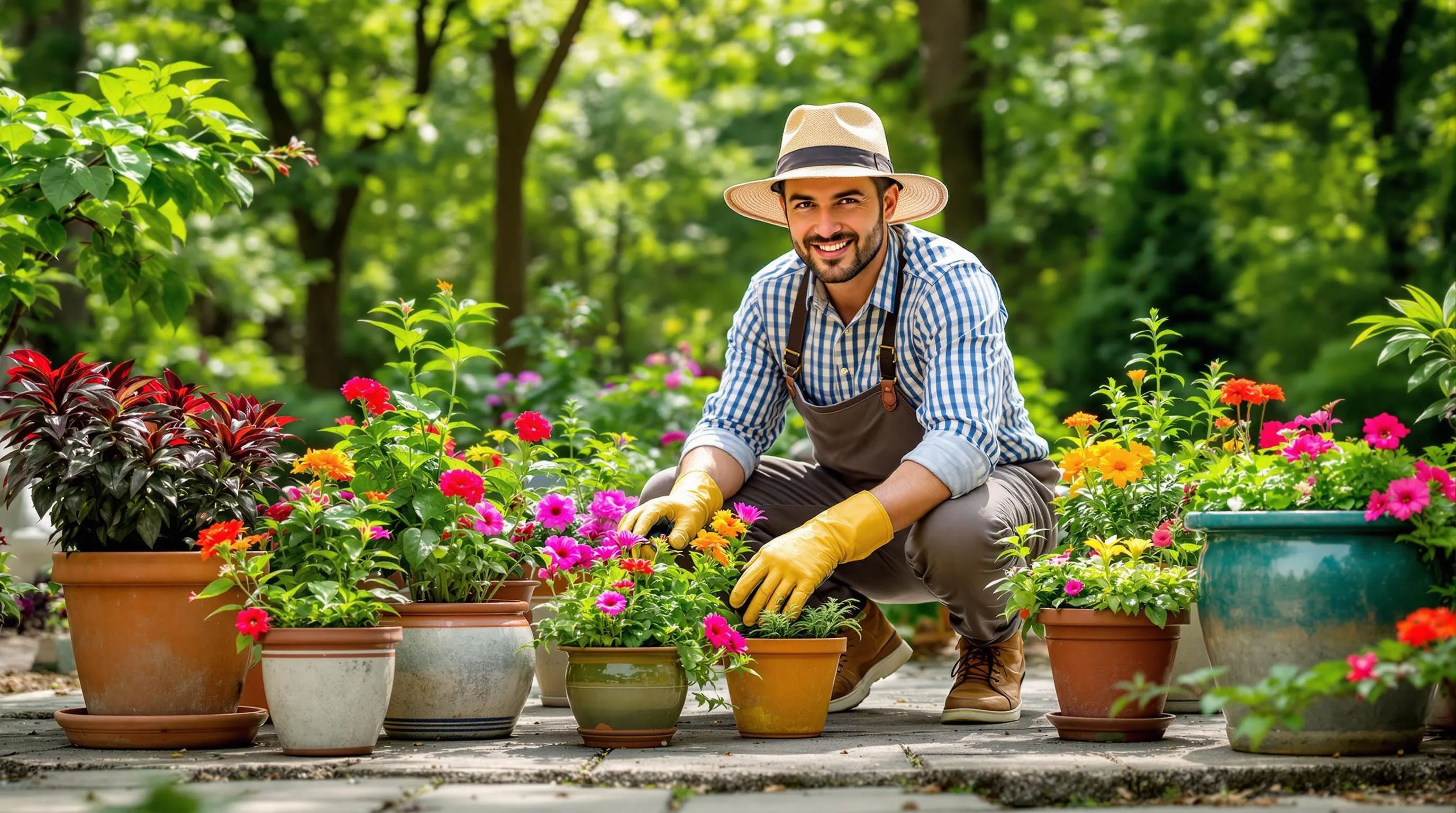
Creating successful container gardens in shade requires exact techniques and considerations beyond just plant selection. These practical tips will help your shade containers thrive and remain vibrant throughout the growing season.
Choosing the Right Pots and Soil
Select containers with adequate drainage holes to prevent waterlogging, which is especially important in shade where evaporation occurs more slowly. Opt for larger pots (at least 12 inches in diameter) as they retain moisture better and provide more root space for shade plants. While plastic or fiberglass containers work well for moisture retention, glazed ceramic pots add visual interest to shady areas. For soil, use a high-quality potting mix specifically formulated for containers rather than garden soil. Add perlite or vermiculite to improve drainage, and incorporate slow-release organic matter like compost to enrich the growing medium. Remember that shade-loving plants often naturally grow in forest floors with rich, humus-filled soil, so replicating these conditions will help your container garden flourish.
Watering and Fertilizing in Shade Environments
Shade containers require different watering practices than sun-exposed pots. While they dry out more slowly, they still need consistent moisture monitoring—check soil dampness by inserting your finger 1-2 inches deep and water when it feels dry at that depth. Water thoroughly until it flows from drainage holes, but avoid creating constantly soggy conditions that can lead to root rot. For fertilizing, use a balanced, water-soluble fertilizer at half the recommended strength every 3-4 weeks during the growing season. Shade plants typically have slower growth rates and need fewer nutrients than sun-loving varieties. Organic options like fish emulsion or seaweed extract work particularly well for shade containers. Apply fertilizer to damp soil to prevent root burn, and reduce feeding in late summer to help plants prepare for dormancy periods. This balanced approach to water and nutrients will keep your shade containers looking their best without promoting weak, leggy growth.
Beautiful Flowering Plants That Thrive in Full Shade
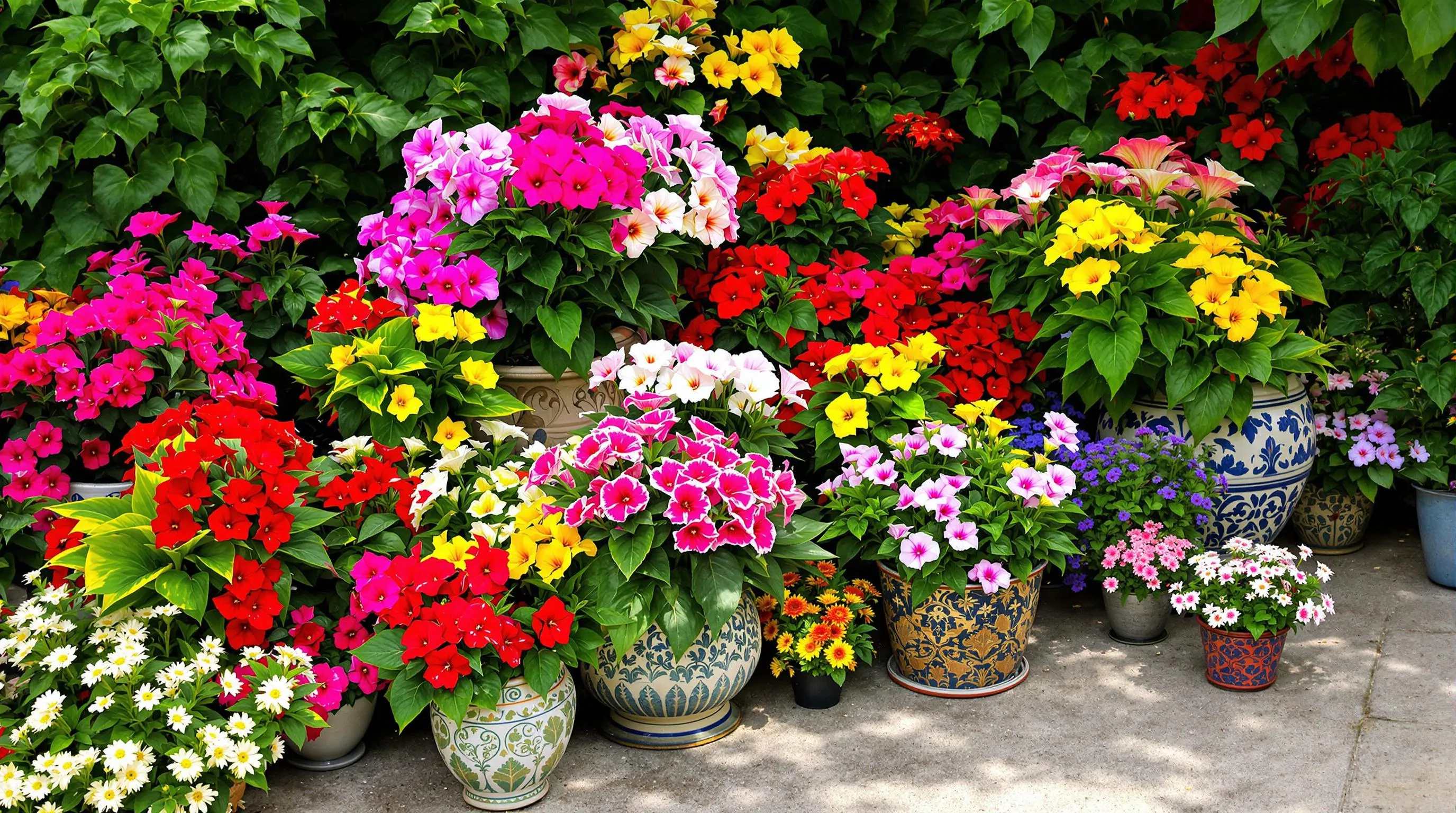
Looking for flowers that will bloom beautifully in the darkest corners of your garden? These shade-loving plants will transform those challenging spots into vibrant displays of color.
Begonias: Colorful Blooms for Deep Shade
Begonias offer incredible versatility for deeply shaded container gardens with their stunning foliage and continuous blooms. These adaptable plants come in many varieties, including tuberous, wax, and rex types, each bringing unique colors and textures to your shady spots. Tuberous begonias display large, rose-like flowers in vibrant reds, oranges, yellows, and pinks that brighten even the darkest corners. Wax begonias provide reliable color with glossy leaves and clusters of smaller blooms that persist from spring through fall. For containers in full shade, choose varieties with bronze or burgundy foliage for added visual interest. They require consistent moisture but hate waterlogged soil, so use containers with good drainage and water when the top inch of soil feels dry.
Impatiens: Reliable Color All Season Long
Impatiens remain the go-to flowering plant for deep shade containers, delivering non-stop blooms without requiring direct sunlight. These versatile annuals produce abundant flowers in white, pink, red, orange, purple, and bicolor patterns from spring until first frost. Traditional impatiens (Impatiens walleriana) create lush mounds up to 12 inches tall, perfect for the center or edges of your shade containers. The New Guinea varieties offer larger flowers and more striking foliage but require slightly more light. For maximum impact, group impatiens in containers by color or create stunning combinations with other shade lovers like ferns or coleus. They thrive in consistently moist soil, making them ideal partners with moisture-loving plants. Feed every two weeks with a balanced liquid fertilizer to maintain their prolific flowering habit throughout the growing season.
Perfect Flowers for Partial Shade Containers
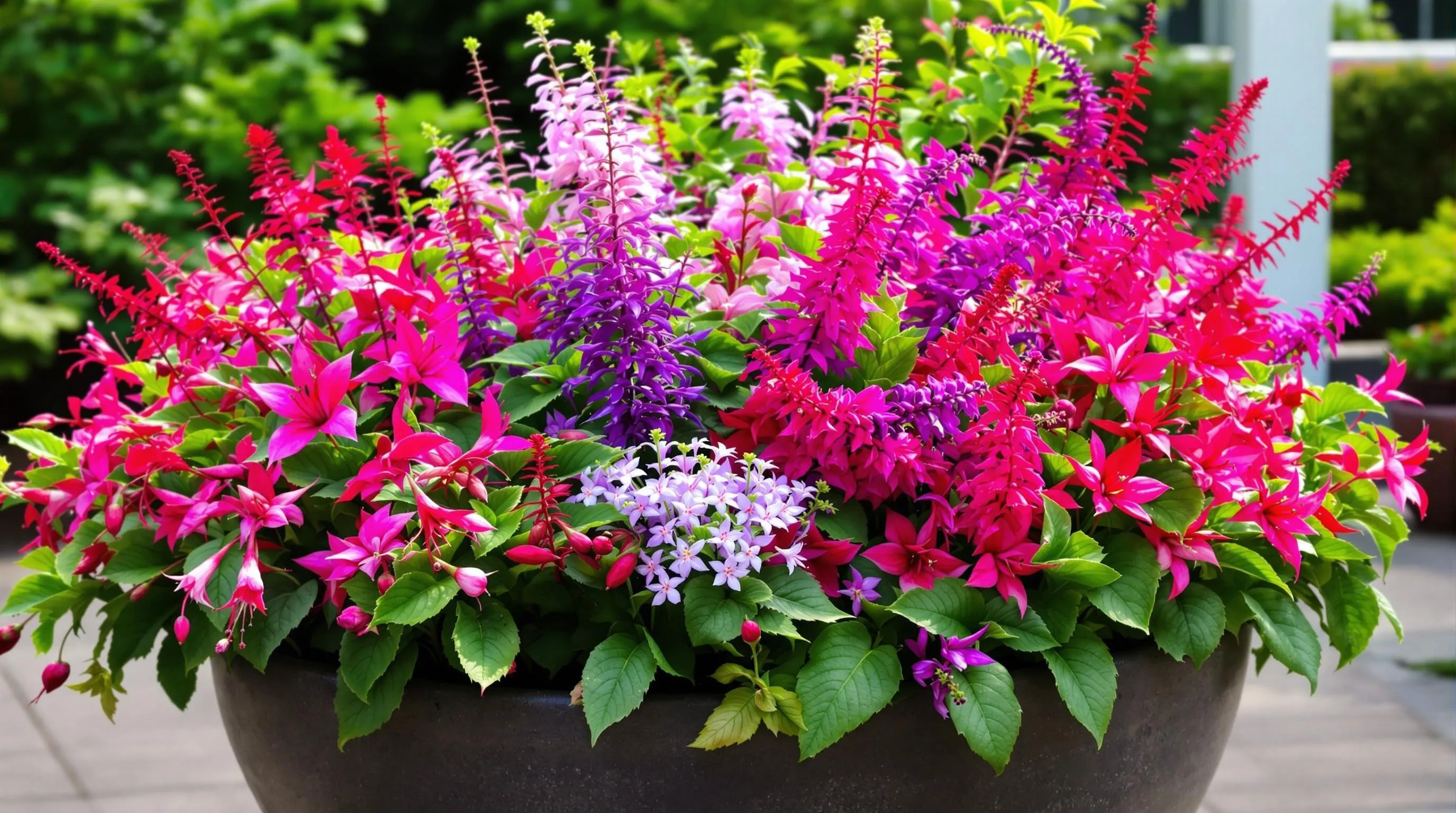
Partial shade areas receive 3-6 hours of direct sunlight daily, creating ideal conditions for many flowering plants that need protection from intense afternoon heat. These versatile bloomers offer the perfect balance of shade tolerance while still producing abundant flowers.
Fuchsias: Elegant Hanging Blooms
Fuchsias transform partial shade containers with their distinctive pendant-shaped flowers in striking color combinations. These showstoppers feature dangling blooms with contrasting sepals and petals in shades of pink, purple, red, and white. For maximum impact, place fuchsias in hanging baskets where their graceful flowers can cascade over the edges. They thrive in temperatures between 55-75°F, making them perfect for cooler shaded areas. Keep the soil consistently moist but not waterlogged, and feed every two weeks with a balanced liquid fertilizer to encourage continuous blooming from spring through fall.
Astilbe: Feathery Plumes for Container Gardens
Astilbes bring architectural interest to partial shade containers with their feathery, plume-like flower spikes that rise above fern-like foliage. These perennials produce fluffy blooms in shades of pink, red, lavender, and white, creating a soft, romantic effect in your container garden. Plant astilbes in rich, moisture-retentive soil and ensure consistent watering to keep them thriving. They pair beautifully with hostas or heucheras for a textural container display. While astilbes prefer morning sun and afternoon shade, their flowering performance remains impressive even with limited direct sunlight. For continuous color, select varieties with different blooming times to extend your display throughout the summer months.
Foliage Plants With Surprising Flowers for Shade Pots
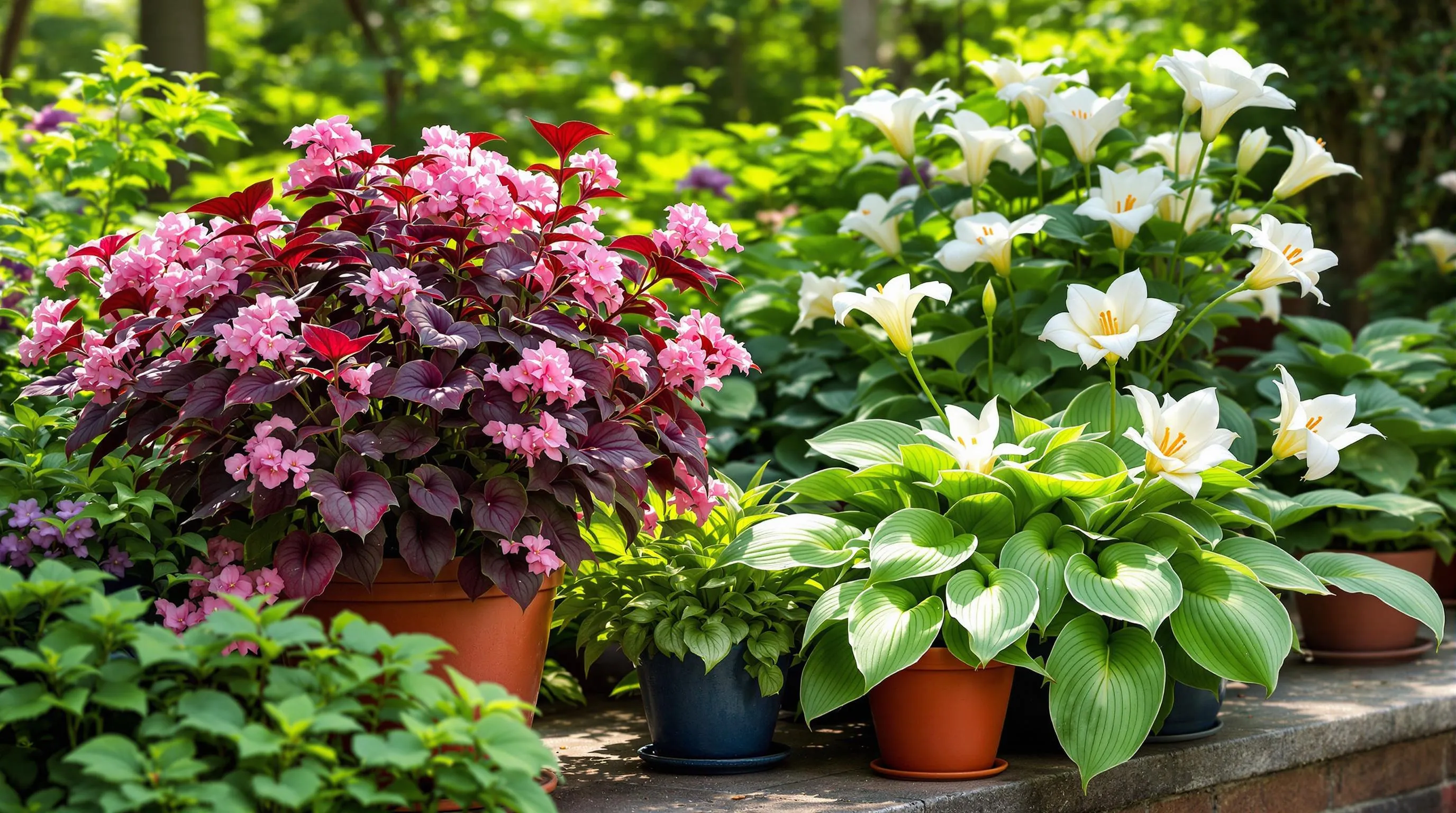
While many gardeners choose foliage plants for shade containers primarily for their leaves, several varieties offer stunning blooms as an unexpected bonus. These dual-purpose plants provide texture and color even when not flowering, making them excellent investments for shady spots.
Heuchera: Colorful Leaves With Delicate Blooms
Heucheras (Coral Bells) deliver year-round impact with their ruffled, colorful foliage in shades ranging from lime green to deep burgundy. What many gardeners don’t expect are the delicate flower stalks that rise 12-24 inches above the leaves in late spring to early summer. These tiny bell-shaped blooms in white, pink, or red attract hummingbirds and add vertical interest to container arrangements. For best results, plant heucheras in well-draining soil and position them where they’ll receive morning sun and afternoon shade. Varieties like ‘Berry Smoothie’ with its vibrant pink leaves and ‘Caramel’ with amber-colored foliage offer particularly striking combinations of leaf color and dainty flowers.
Hostas: Beyond Just Foliage
Hostas are renowned shade garden workhorses for their impressive foliage, but their flowering capabilities deserve more attention. From mid-summer to early fall, hostas produce elegant flower spikes in white or lavender that rise well above their leafy mounds. These fragrant blooms attract pollinators and create wonderful vertical elements in container arrangements. Varieties like ‘Fragrant Bouquet’ offer particularly sweet-scented flowers, while ‘Guacamole’ produces large, lily-like white blooms that stand out dramatically against its chartreuse and green variegated leaves. For container growing, choose compact varieties like ‘Blue Mouse Ears’ or ‘Pandora’s Box’ that won’t outgrow their pots too quickly. Ensure your containers have drainage holes and use rich potting soil mixed with compost for optimal growth and flowering.
Bulbs and Tubers for Shaded Container Gardens
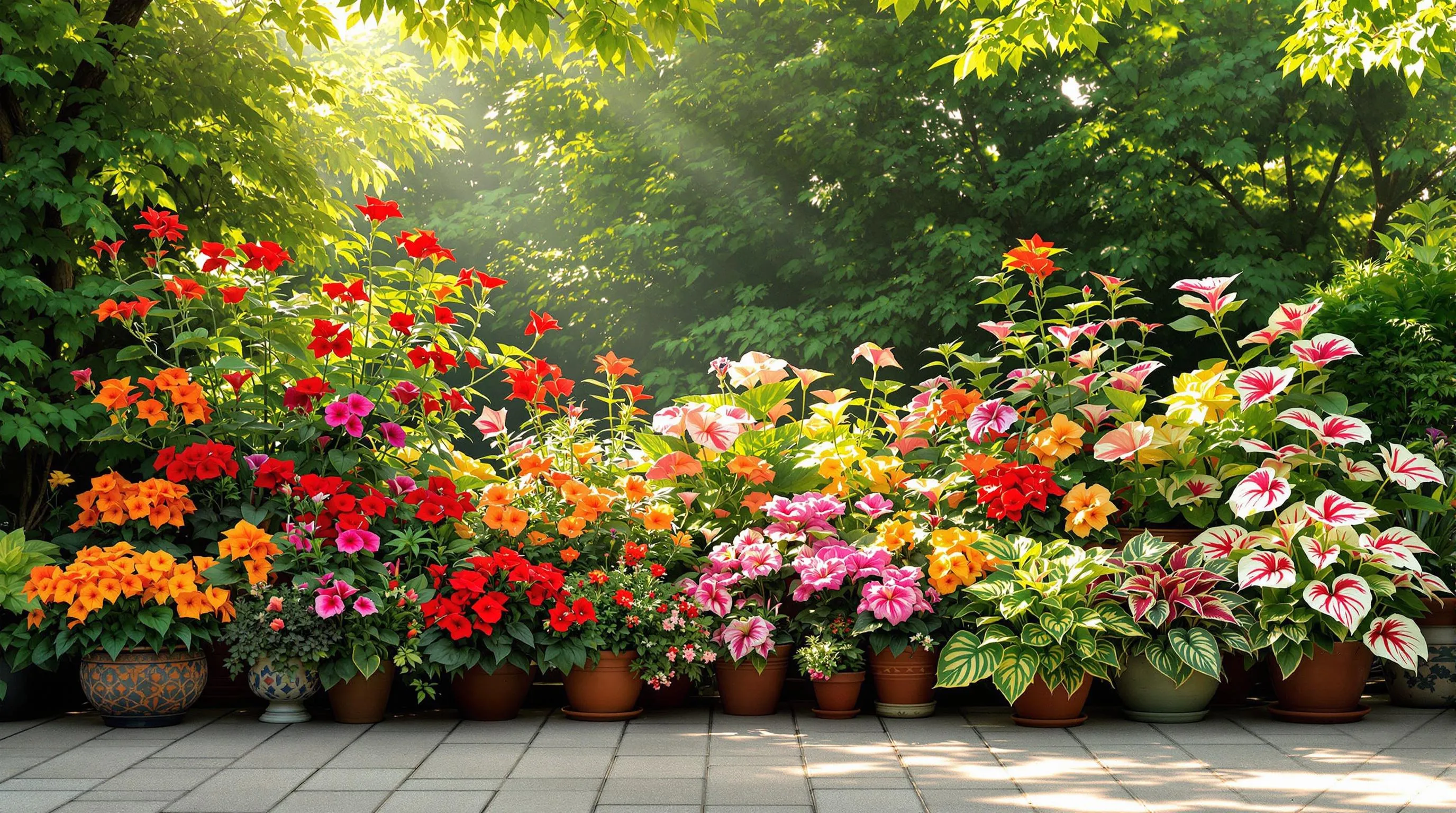
Bulbs and tubers offer spectacular options for adding color and texture to shaded container gardens with minimal maintenance. These versatile plants store energy in their modified root systems, allowing them to produce impressive displays even in low-light conditions.
Tuberous Begonias: Dramatic Blooms for Pots
Tuberous begonias deliver show-stopping blooms in shady container gardens with their large, rose-like flowers in vibrant reds, oranges, yellows, pinks, and whites. These shade-lovers thrive in containers with rich, well-draining soil and perform best in dappled to partial shade where they’re protected from intense afternoon sun. Plant the tubers concave side up, just below the soil surface in spring after all danger of frost has passed. For optimal growth, keep the soil consistently moist but never soggy, and fertilize every two weeks with a balanced, water-soluble fertilizer. Tuberous begonias make stunning focal points in containers, with compact varieties like ‘Nonstop’ and ‘Illumination’ series being particularly well-suited for pot culture, reaching just 8-12 inches in height while producing abundant blooms from summer until frost.
Caladiums: Tropical Beauty in the Shade
Caladiums transform shaded pots with their heart-shaped, paper-thin leaves in striking patterns of pink, red, white, and green. These tropical tubers thrive in warm, humid conditions and provide instant impact in shady spots where flowering plants struggle. Plant caladium tubers about 1-2 inches deep in containers filled with rich, well-draining potting mix once temperatures consistently remain above 65°F. Varieties like ‘White Christmas’ with its white leaves and green veins, and ‘Red Flash’ with dramatic red centers and green edges, create eye-catching displays without needing direct sunlight. Water regularly to keep soil consistently moist and apply a slow-release fertilizer monthly throughout the growing season. Caladiums pair beautifully with ferns, impatiens, or coleus in mixed shade containers, adding tropical flair and season-long color with virtually no maintenance beyond regular watering.
Creating Stunning Container Combinations for Shade
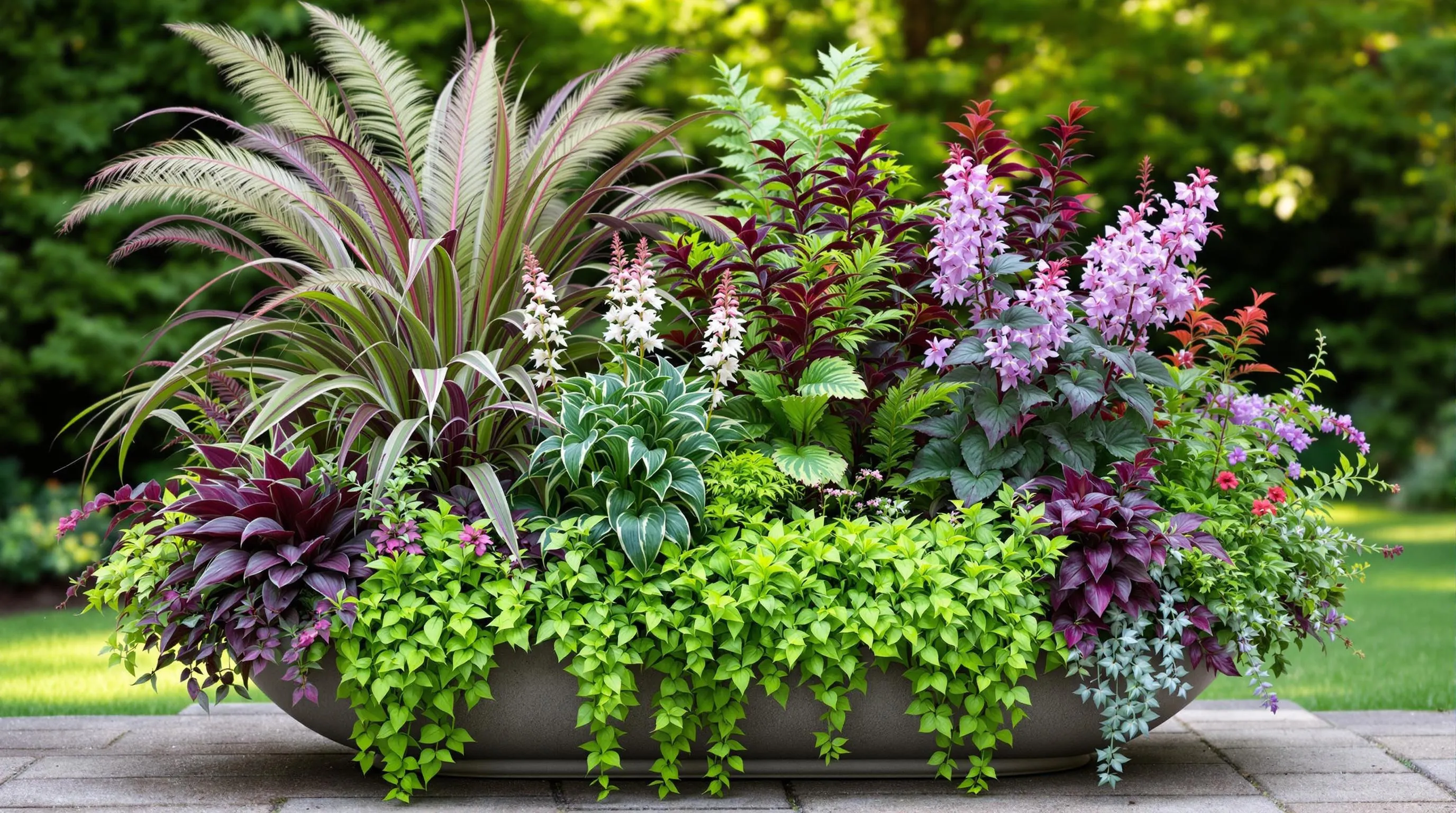
Thriller, Filler, and Spiller Technique
The thriller, filler, and spiller technique is your secret weapon for creating ever-changing shade containers with professional-level appeal. Start with a thriller—a tall, eye-catching plant like Japanese forest grass, Astilbe, or Caladium—positioned toward the back or center of your container. Add fillers such as Heuchera, Impatiens, or Begonias to create mid-level fullness around your thriller. Finally, incorporate spillers like Creeping Jenny, Bacopa, or Torenia that cascade over the edges, softening the container’s lines. This three-part approach creates instant visual interest with varied heights and growing habits, even in low-light conditions. For deeper shade, try ferns as thrillers, Coleus as fillers, and variegated ivy as spillers to maximize color impact without requiring direct sunlight.
Color and Texture Combinations That Pop in Shade
In shade gardens, strategic color and texture pairings make all the difference in creating containers that stand out even though limited light. Combine silver-leaved plants like Japanese painted fern with dark purples from Heucheras for a striking contrast that’s visible even in deep shade. Incorporate plants with different leaf sizes—pair large-leaved Hostas with delicate ferns and fine-textured grasses for textural interest. White, pale yellow, and light blue flowers naturally reflect what little light is available, making them appear to glow in shadowy spots. Consider unexpected color combinations like coral Begonias with lime-green Heucheras or silver Lamium with purple Torenia. Add plants with variegated foliage such as Brunnera ‘Jack Frost’ or Japanese forest grass to brighten dark corners. Remember that in shade, foliage often outperforms flowers, so prioritize interesting leaves in different shapes, sizes, and colors for long-lasting visual impact.
Seasonal Considerations for Shaded Container Gardens

Spring to Summer Transitions
Spring marks the perfect time to refresh your shade containers with early bloomers that thrive before tree canopies fully develop. Start with spring bulbs like snowdrops and grape hyacinths that can handle dappled light. As temperatures rise, gradually introduce fuchsias and begonias which appreciate the cooler spring conditions before summer heat arrives. For a smooth transition, plant coleus alongside spring flowers—they’ll remain vibrant as spring blooms fade. Deadhead spent flowers regularly to encourage continuous blooming throughout the season. By mid-spring, consider adding tropical foliage plants like caladiums that will reach their peak during summer months. Maintain consistent moisture during this transition period, as containers dry out more quickly with rising temperatures.
Fall and Winter Container Options
Don’t abandon your shade containers when temperatures drop! For fall displays, incorporate ornamental kale, cyclamen, and autumn ferns that thrive in cooler conditions and lower light levels. Hellebores (Lenten roses) are exceptional winter performers in containers, often blooming between January and March in milder climates. Evergreen plants like dwarf conifers, boxwoods, and certain heuchera varieties provide structure and color throughout winter months. In colder regions, protect container roots by wrapping pots in burlap or moving them closer to your home’s foundation. Winter-flowering pansies and violas can survive light frosts while adding welcome color. Consider incorporating plants with interesting bark or berries like red-twig dogwood or winterberry holly for visual interest when blooms are scarce. Replace summer-flowering annuals with these cold-tolerant options to maintain attractive displays year-round.
Troubleshooting Common Problems With Shade Container Gardens
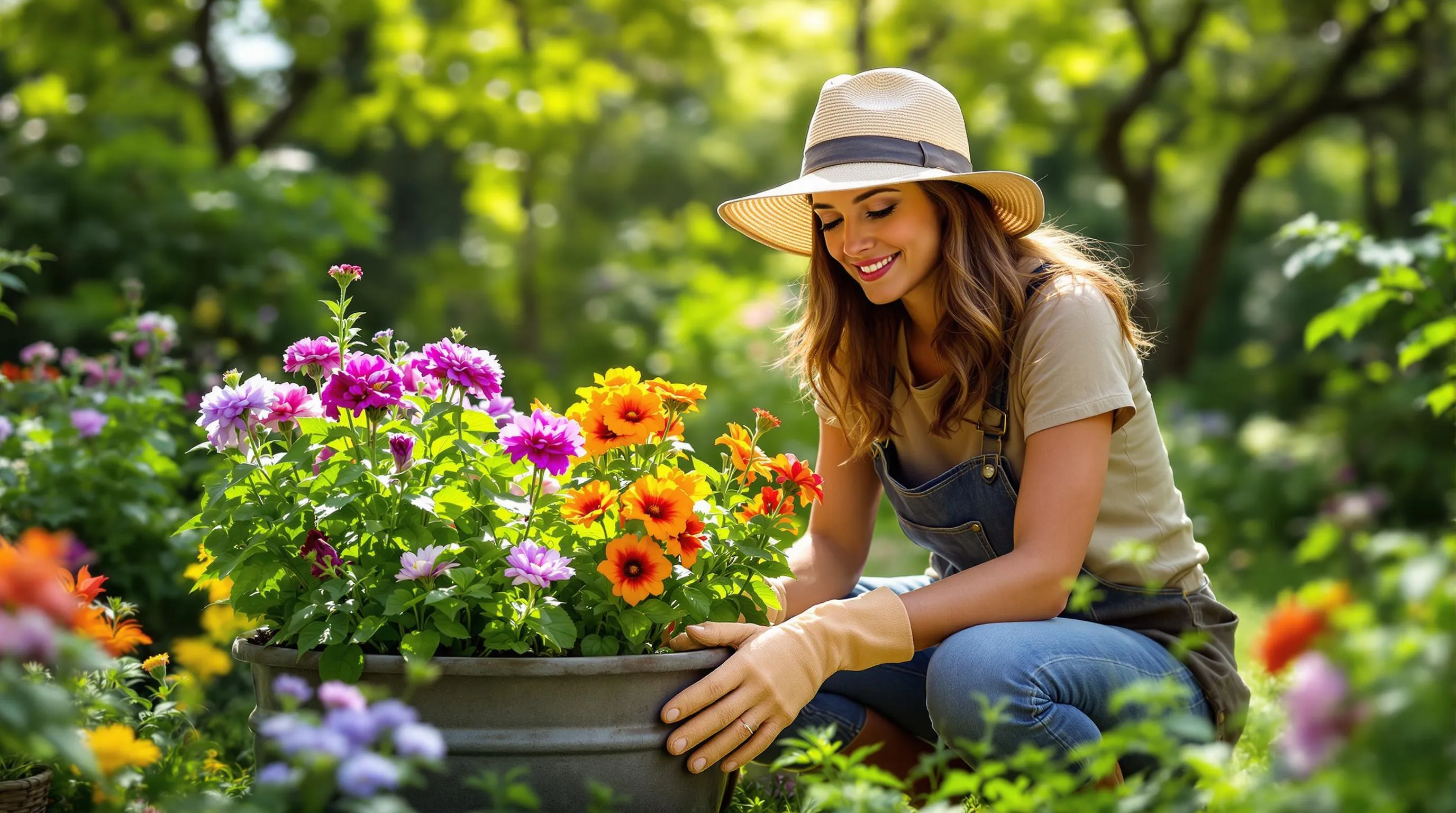
Even the most carefully planned shade container gardens can encounter challenges. Identifying and addressing these issues quickly will keep your shade-loving plants thriving throughout the growing season.
Pest Management in Shady Conditions
Shaded containers often create the perfect environment for pests that thrive in cool, moist conditions. Slugs and snails frequently target shade gardens, leaving behind telltale slime trails and holes in foliage. Combat these pests by placing copper tape around pots or using diatomaceous earth as a barrier. Fungus gnats can also become problematic in consistently damp soil—allow the top inch of soil to dry between waterings to disrupt their lifecycle. Spider mites may attack stressed plants in dry shade; increase humidity by misting foliage regularly. For persistent infestations, consider neem oil or insecticidal soap applications, focusing on leaf undersides where pests hide. Always inspect new plants thoroughly before adding them to your container groupings, as this prevents introducing unwanted visitors to your shade garden.
Addressing Poor Blooming Issues
When shade container plants fail to produce the expected blooms, several factors may be responsible. Insufficient light is the most common culprit—even shade-tolerant plants need some filtered light to generate flowers. Try relocating containers to spots with morning sun or brighter dappled shade. Nutrient deficiencies often manifest as reduced flowering; apply a phosphorus-rich fertilizer (the middle number in the NPK ratio) to encourage bud development. For plants like begonias and fuchsias, deadhead spent blooms regularly to redirect energy toward new flower production. Overwatering can also hinder flowering by promoting root rot; ensure containers have proper drainage and check soil moisture before watering. If your plants produce abundant foliage but few flowers, they may need pruning to stimulate new growth points. Remember that some shade plants naturally bloom less profusely than sun-loving varieties—appreciate their foliage and the subtle beauty of their limited flowers.
Conclusion: Bringing Life to Shaded Spaces With Container Gardens
Your shaded areas are now ready to become stunning focal points with the right container plants. By selecting appropriate shade-loving flowers and foliage plants you can create eye-catching displays that thrive without direct sunlight.
Remember that success comes from understanding your exact shade conditions matching plants accordingly and implementing proper container gardening techniques. The thriller-filler-spiller approach will help you design balanced compositions while paying attention to seasonal needs ensures year-round interest.
With these strategies you’ll transform once-overlooked shady spots into vibrant garden spaces that make a statement. Your containers will flourish with rich textures and surprising blooms proving that shade doesn’t limit your gardening creativity but rather opens up new and exciting possibilities.





